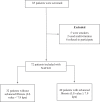Association between serum and dietary antioxidant micronutrients and advanced liver fibrosis in non-alcoholic fatty liver disease: an observational study
- PMID: 32995080
- PMCID: PMC7502233
- DOI: 10.7717/peerj.9838
Association between serum and dietary antioxidant micronutrients and advanced liver fibrosis in non-alcoholic fatty liver disease: an observational study
Abstract
Background: Despite clinical trials with antioxidant supplementation, few studies have been conducted to evaluate the nutritional status of antioxidant vitamins and minerals, and none have reported on the status of these serum antioxidants associated with the dietary intake of antioxidants by non-alcoholic fatty liver disease (NAFLD) patients.
Objective: To evaluate association between serum and dietetics antioxidants with liver fibrosis in patients with NAFLD.
Methods: Across-section analysis with out with 72 patients diagnosed with NAFLD. Hepatic fibrosis was measured by FibroScan®, and liver stiffness ≥7.9 kPa was considered to indicate advanced fibrosis. Retinol, alpha-tocopherol, ascorbic acid, beta-carotene, serum zinc, and selenium were evaluated, as was the dietary intake of these micronutrients in the previous 24 h (using 24-h dietary recall). The Mann-Whitney test was used to compare the fibrosis groups and, a linear regression analysis was performed to determine associated risk factors between age, sex, BMI, hepatic fibrosis, and serum antioxidants.
Results: A high proportion of inadequate serum retinol (20.8%), vitamin C (27%), and selenium (73.6%) was observed in the patients with NAFLD, in addition to a significant inadequacy of vitamin A (98.3%) and vitamin E (100%) intake. Patients with advanced liver fibrosis had reduced levels of serum retinol (P = 0.002), with liver fibrosis being the independent risk factor associated with serum retinol lower.
Conclusion: Hepatic fibrosis was associated with a reduction in serum retinol and was reduced in advanced fibrosis. NAFLD patients showed an important serum deficiency and insufficient dietary intake of the evaluated micronutrients.
Keywords: Antioxidants; Elastography; Liver fibrosis; Micronutrients; NAFLD; Retinol; Selenium; Vitamin C; Vitamin E; Zinc.
© 2020 Coelho et al.
Conflict of interest statement
The authors declare that they have no competing interests.
Figures


References
-
- Angulo P, Kleiner DE, Dam-Larsen S, Adams LA, Bjornsson ES, Charatcharoenwitthaya P, Mills PR, Keach JC, Lafferty HD, Stahler A, Haflidadottir S, Bendtsen F. Liver fibrosis, but no other histologic features, is associated with long-term outcomes of patients with nonalcoholic fatty liver disease. Gastroenterology. 2015;149(2):389–397. doi: 10.1053/j.gastro.2015.04.043. - DOI - PMC - PubMed
-
- Cankurtaran M, Kav T, Yavuz B, Shorbagi A, Halil M, Coskun T, Arslan S. Serum vitamin-E levels and its relation to clinical features in nonalcoholic fatty liver disease with elevated ALT levels. Acta Gastroenterology Belgica. 2006;69:5–11. - PubMed
-
- Caussy C, Ajmera VH, Puri P, Hsu CLS, Bassirian S, Mgdsyan M, Singh S, Faulkner C, Valasek MA, Rizo E, Richards L, Brenner DA, Sirlin CB, Sanyal AJ, Loomba R. Serum metabolites detect the presence of advanced fibrosis in derivation and validation cohorts of patients with non-alcoholic fatty liver disease. Gut. 2019;68(10):1884–1892. doi: 10.1136/gutjnl-2018-317584. - DOI - PMC - PubMed
LinkOut - more resources
Full Text Sources

